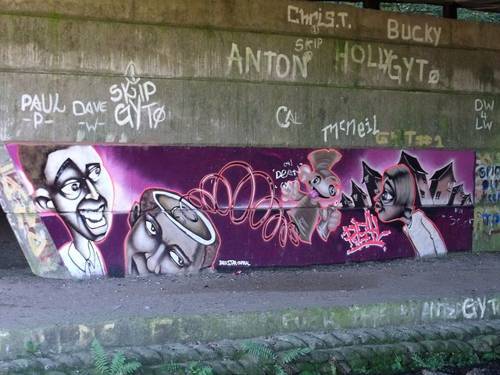
FAQ About The Role of Cultural Graffiti in Urban Storytelling

What is cultural graffiti?
Cultural graffiti is a form of street art that reflects the local identities, stories, and socio-political messages of a community. It tends to offer insightful commentary on cultural dynamics and often serves as an informal narrative tool within urban environments.

How does graffiti contribute to urban storytelling?
Graffiti contributes to urban storytelling by using the cityscape as a canvas to depict local stories, historical events, social issues, and cultural identities. Through vibrant visuals and text, artists can convey complex narratives that engage public audiences and provoke thoughtful discussions.

What themes are commonly found in cultural graffiti?
Cultural graffiti often explores themes such as resistance and protest, identity and belonging, historical memory, social justice, and community pride. These artworks can critique social norms and policies, celebrate cultural heritage, or bring attention to forgotten stories within a community.

Why is graffiti considered a powerful socio-political tool?
Graffiti is a powerful socio-political tool because it provides an accessible platform for underrepresented voices to express dissent, raise awareness, and challenge the status quo. It can effectively draw public attention to pressing issues and spark movements for social change.

How can graffiti affect local communities?
Graffiti can significantly affect local communities by fostering a sense of identity and pride, enhancing community engagement, and influencing public perception. While some see it as vandalism, many recognize its potential to beautify urban spaces and promote tourism.

What role does graffiti play in reflecting cultural identity?
Graffiti plays an essential role in reflecting cultural identity by depicting symbols, language, heroes, and narratives specific to a community's heritage. It helps inhabitants and outsiders alike understand the cultural fabric of an area through personal and collective stories.

Are there any famous examples of cultural graffiti?
Yes, famous examples of cultural graffiti include the Berlin Wall artworks in Germany, Banksy's politically charged street art across the UK, and the vibrant murals of the Mission District in San Francisco. These works have each become iconic symbols that narrate important cultural and historical moments.

What is the difference between graffiti and street art?
While both graffiti and street art consist of artistic expressions in public spaces, graffiti typically involves stylized lettering and tags, often unauthorized. Street art is broader and includes various forms like murals, stencils, and posters, which may sometimes be created with permission.

How does graffiti influence the perception of urban spaces?
Graffiti can influence the perception of urban spaces by transforming ordinary, mundane areas into vibrant creative hubs that reflect local culture and issues. It can alter the way people interact with their environment, turning a city’s less noticed corners into focal points of interest.

Is graffiti legal in most cities?
In most cities, unauthorized graffiti is considered illegal due to property laws and regulations. However, some cities have designated areas or "free walls" where artists can legally create graffiti. Policies vary significantly, affecting how cultural graffiti is presented and preserved.

Can graffiti have a positive economic impact on cities?
Graffiti can have a positive economic impact on cities by attracting tourists, inspiring local creativity, and contributing to the arts and culture sector. Murals and street art often enhance the aesthetic appeal of neighborhoods, which can lead to increased foot traffic and business opportunities.

Why is graffiti often associated with vandalism?
Graffiti is often associated with vandalism because it involves altering public or private property without permission, which can result in damage and costly clean-up efforts. This has led to the perception of graffiti as a criminal act, despite its artistic merits.

How has graffiti evolved over the years?
Graffiti has evolved from its roots in ancient times to the modern urban expressions we see today. It began as simple inscriptions and evolved into complex visual narratives and styles influenced by hip-hop culture, political movements, and digital design technologies.

How do artists choose locations for their graffiti?
Artists choose locations for their graffiti based on visibility, message impact, and a site's cultural or historical significance. Strategic placement can maximize audience engagement and ensure that socio-political messages reach the intended public effectively.

What tools and materials are commonly used in creating graffiti?
Common tools and materials for creating graffiti include spray paint, stencils, markers, and brushes. Artists may also use projectors for large-scale murals. The choice of tools often depends on the style, message, and scale of the artwork being created.

How can graffiti be preserved for future generations?
Preserving graffiti requires efforts such as documentation, protective coatings, and community support. Photographing murals and maintaining digital archives help keep the art accessible, while public backing can ensure that local governments protect important pieces against removal.

What challenges do graffiti artists face?
Graffiti artists often face challenges including legal issues, limited access to resources, public misperception, and the impermanence of their work. Navigating these hurdles requires creativity, resilience, and sometimes collaboration with communities or city councils.

How do communities respond to graffiti?
Community responses to graffiti are mixed. Some view it as art that enhances cultural identity and aesthetic value, while others see it as unwelcome vandalism. Successful projects often involve community engagement and permission, resulting in more positive receptions.

What is "graffiti tourism," and how does it impact cities?
"Graffiti tourism" refers to visitors traveling to view urban street art and murals. It positively impacts cities by boosting local businesses, increasing cultural exchange, and drawing attention to neighborhoods, sometimes leading to cultural revitalization or gentrification.

Can graffiti be used as an educational tool?
Graffiti can serve as an educational tool by fostering discussions on cultural heritage, social issues, and artistic expression. Educators may use it to engage students in dialogues about history, identity, and even urban planning, highlighting its relevance in modern society.
